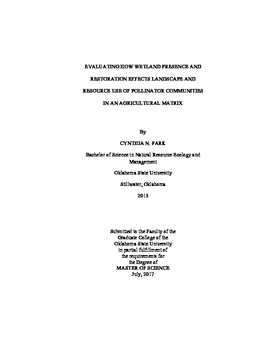| dc.description.abstract | Pollination is critical for ensuring biodiversity and human food supplies. However, wild pollinator populations are declining due to fragmentation and loss of habitat. These concerns are apparent in the Rainwater Basin of Nebraska, where more than 90% of the region has been cultivated. The small number of playa wetlands and their adjacent uplands present in this region are the only natural habitat available for pollinators. My objective was to document wild pollinating insects in south-central Nebraska and observe how they utilize the landscape for habitat and food resources. I used blue vane traps to passively collect insects and insect nets to obtain actual habitat and foraging information from April through October in 2014 and 2015. I compared pollinator abundance, richness, and diversity by insect order in wetlands and uplands within three land uses: cropland, reference condition, and restored sites implemented through the Wetlands Reserve Program. Net data for dominant pollinating families were analyzed using a Principle Response Curve to observe the effects of land use, watershed position, and dominant food plant on foraging habits. Additionally, vegetation data were collected using the step-point intercept method to determine differences in plant community among land uses. Dominant plant species were analyzed using a Partial Canonical Correspondence Analysis.Numerous insect orders were collected, but bees were dominant. Trap data showed bees used restored and reference uplands over wetlands and croplands, most likely due to nesting resources only being available in watershed grasslands. Net collections showed bees foraged more in wetlands than uplands, especially in wetlands that have undergone restoration. However, in September, bees foraged in uplands and crop wetlands more than restored or reference wetlands in order to feed on late season forbs. Apidae exhibited strong associations with smartweeds and goldenrods in late summer, neither of which were associated with restored sites. To ensure viable pollinator communities throughout the growing season, restoration practices should provide more diverse wetland flora and additional late season upland forbs than is being currently provided. Additional pollinating orders discussed include Diptera, Coleoptera, and Lepidoptera. | |
